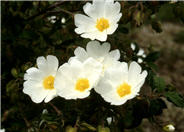
Common name:Sageleaf Rockrose
Botanical name:Cistus salviifolius
This low-spreading shrub reaches a size of 2' tall by 6-8' wide. It bears white flowers that are 1" wide with yellow centers. This variety makes a good groundcover. The plant requires average to good drainage, and little or no summer watering when established. It should be grown in sun or part shade. -Monterey Bay Nursery

Common name:Rosemary
Botanical name:Rosmarinus officinalis
Rosemary is hardy in full sun areas where winter temperatures do not drop below 10 degrees F. They can be grown in a clay pot with well-drained, porous soil in bright indoor light, and will also flourish on the backporch in spring, summer and fall. Its beautiful, slowly trailing stems and shiny slender leaves are perfect for showing off the small light blue flowers that blossom in the summer. -Holland WIldflower Farm

Common name:Bearberry Cotoneaster
Botanical name:Cotoneaster dammeri
This prostrate, trailing evergreen shrub is primarily used as a ground cover. It is highlighted with bright green, ovate to rounded leaves with prominent veins. In the fall, Bearberry Cotoneasters are accented by small, bright red berries.

Common name:Blue Star Creeper, Isotoma
Botanical name:Pratia pedunculata
Laurentia fluviatilis has bright green, nearly stemless, 1/4" leaves. In late spring and summer, these form a backdrop for equally tiny, star-shaped pale blue flowers.

Common name:Oregon Grape
Botanical name:Mahonia aquifolium
Exhibiting erect growth, this evergreen shrub grows to a height of 6'. The leaves are 4-10" long, with 5-9 very spiny-tooted, oval, leaflets that are 1 1/2" in length.
| Designer: | Rectangular-Look Pavers |
Photographer: GardenSoft |
Soils and Compost:
Incorporate compost 6" into your soil to retain water, reduce compaction, feed earthworms, and provide valuable nutrients to your plants.
Water Saving Tip:
Use water saving equipment, e.g. rain or soil-moisture sensors, MP rotator nozzles, weather-based controllers, and low-volume irrigation (drip systems, soaker hoses, and microsprayers).
Integrated Pest Management:
Drip and other smart irrigation delivers water directly to roots, allowing no excess water for weeds.

